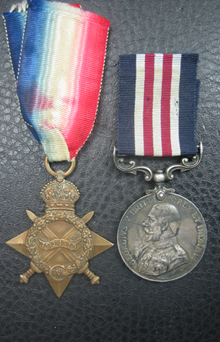
MILITARY MEDAL G.IV ‘79004 CPL.F.WOODWARD.NO.11.SQ.R.F.C.’, 1914-15 STAR ‘1964 PTE. F. WOODWARD. WEST. & CUMB. Y.’
M.M. London Gazette 21 August 1917. The original recommendation, dated 3 July 1917, states:
“No. 11 Squadron R.F.C. 315076 Corporal Frank Woodward.
For skill, gallantry and devotion to duty as observer.
On the 26th June, 1917, near ETAING he attacked several enemy aircraft, crashing one and bringing down another out of control. His pilot then was mortally wounded and semi conscious, but this N.C.O. kept his hand on the controls and assisted his pilot to fly the machine back from EAST of CAMBRAI landing safely on a British Aerodrome.
This N.C.O. has on many previous occasions performed very gallant work.
(Sgd) J. F. A. Higgins Brigadier-General. Commanding 3rd. Brigade, Royal Flying Corps.”
During the early evening of 26 June, 1917, a patrol of 11 Squadron Bristol F2b Fighters encountered ten enemy fighters of Jasta 12 under Obln von Tutschek , two of which attacked Lieutenant A. E. McKeever and 2nd Lt E Oaks from behind, but both were driven down and one fell out of control. Immediately after this they attacked another enemy fighter which they destroyed and Lieutenant G. H. Hooper and Corporal Carr destroyed another. However four other enemy fighters engaged Bristol Fighter A7154, piloted by 2nd Lieutenant P. C. Ross and 2/Airman F. Woodward, woodward destroying one of the fighters and driving another down out of control. 2nd Lieutenant Ross was mortally wounded during the engagement but with the help of Woodward, brought back his machine safely, however Ross had been shot in the heart and died shortly after landing.
With no piloting experience, for Woodward to be able to help control the aircraft for some distance and subsequently safely land the aircraft was some feat, especially as enemy fighters were clearly in the area. The pilot and observers cockpits are closer together than on many similar two seaters, however Woodward must have had to either lean totally out of his cockpit onto the fuselage and over Ross to reach the controls. Or in flight, someone get out from his cockpit and squeeze into Ross’s. Either way, it must have been an extremely hair raising experience. Woodward’s Service Record notes he was “Promoted for gallantry 28 6 17”, so clearly for his actions above and five days later he was recommended for the Military Medal.
Frank Woodward from Bishop Auckland, Durham, was born on 15 May 1887. He enlisted into the Army on 21 November 1911 as a boy soldier. Serving with the Westmorland and Cumberland Yeomanry, he entered the French theatre of War on 28 July 1915. Transferring to the Royal Flying Corps as a 2/AM on 17 May 1917 and was posted to 11 Squadron (Bristol F2b Fighters), he qualified as an Aerial Gunner on 30 May 1917. Promoted Corporal for gallantry on 28 June 1917. It seems prior to transferring to the Royal Flying Corps, Woodward had been serving as an unqualified gunner/observer, for on 13 May 1917, he is noted as being in and FE2b of 11 Squadron. Piloted by 2nd Lieutenant R. W. G. West, that Stalled in flight due engine boiling on close patrol. Both pilot and Observer, OK. On 30 October, his Bristol Fighter, no A7159, piloted by 2nd Lieutenant J H Wallace, Landed downwind and struck pile of timber after photo recce. Both pilot and Observer OK.
Woodward is still recorded as flying with 11 Squadron until at least February 1918, transferring to the Royal Air Force on 1 April 1918, with the rank of Corporal Mechanic. Service record notes service with 3 Brigade, 64th Wing post April 1918 and with 46 Squadron between May and August 1918. After this, details are hard to read, however none of his service with the Royal Air Force was overseas. He was discharged for the Royal Air Force on 14 December 1918 due to Shell Shock. Trades given as Armourer and Observer.
Service records note he served in France with the Royal Flying Corps between 17 May 1917 and 17 March 1918. He was awarded the Silver War Badge, no. R.A.F. 10784, so he was presumably either wounded or injured in a flying accident at some time, probably the latter as he was discharged in late 1918. Whether there were any other combats involving Woodward is unknown. Unfortunately few of the combat reports for 11 Squadron have survived.
Approximately 167 M.M.’s, and 2 Second Award Bars were awarded to the Royal Flying Corps for the Great War, the vast majority of which were to non flying personnel.
Condition VF, rear of suspension of M.M. at rod, with brooch pin added. Clearly Woodward wore this medal on his uniform. His Star has no such bar and he is further entitled to the BWM/Victory, which would have been issued in the 1920’s. Sold with copy service papers, MIC’s. LG, M.M. recommendation and other research (on CD).
A very scarce ‘flying’ award Military Medal, with extremely fine recommendation for gallantry.